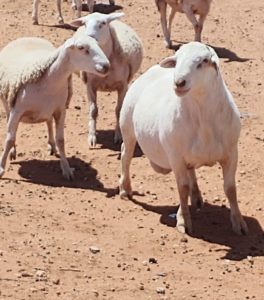Towards the end of 2017 SAFE started a new project with a sheep stud at Nuwepos, the company’s 108 ha farm near Vanrhynsdorp on the Olifants River.
“We started the stud as a community enterprise development project, in partnership with the farm workers who are already involved with the commercial sheep farming operation at Nuwepos,” says Dries van Rooyen, SAFE’s general manager of farming operations.
“We acquired about 70 Dorper ewes and later two rams on an auction in October, and plan to establish a solid infrastructure including pastures as soon as we get some rain. In the meantime, we’re building lambing pens and should be ready by about September to start with the process of creating a strong gene pool. This should take three to four years, by which time we expect the venture to be starting to turn a profit.
“We have already registered our stud at the Dorper Sheep Breeders’ Society of South Africa, and our farm workers will attend Dorper courses. Although they are already familiar with commercial sheep farming, stud farming is much more intensive and there is a lot to learn.”
According to the Dorper Sheep Breeders’ Society of South Africa the Dorper breed was developed in the 1930s by the Department of Agriculture of South Africa through crossing Dorset Horn rams with Blackhead Persian ewes.
The initial need was to produce a relatively easy care sheep breed with an acceptable meat carcass suitable to the demanding low rainfall areas of the country.
Among the characteristics required for the breed were versatility, a satisfactory lambing ability in the autumn, resistance to cold wind and rain as well as extremely high summer temperatures, and the ability to thrive on tough grass and shrub veld.
The breed soon proved itself as a hardy mutton sheep with a top quality carcass at a relative early age, and in 1946 the breed project was finalised and the Dorper Breeders Society was establish in 1950 at the Grootfontein College of Agriculture.
According to the society, the Dorper breed is now numerically the second largest in South Africa, and the estimated number of Dorpers in the country has increased to over 7 million, from 2.6 million in 1963.
Although the Dorper breed was declared indigenous to South Africa, its outstanding qualities have made it popular all over the world in countries as diverse as Australia, New Zealand, the United Kingdom, Middle East, China, Canada, Germany, Switzerland, Brazil, Argentina, South America, Mexico, United States, various African countries, Israel and Namibia.
The early Dorpers were white with black patches all over the body, but the breeding was further refined to produce the even colour distribution of today’s Dorpers – the Blackhead Dorpers with their distinctive white bodies and black heads, as well as White Dorpers, such as those at Nuwepos.
Dries says the main objective of the Dorper stud project at Nuwepos is to promote community enterprise development, and the end plan is to expand the operation to about 1 000 sheep.
“For now, we are marking time until the end of the drought, after which we will get the operation going full steam,” he says.

